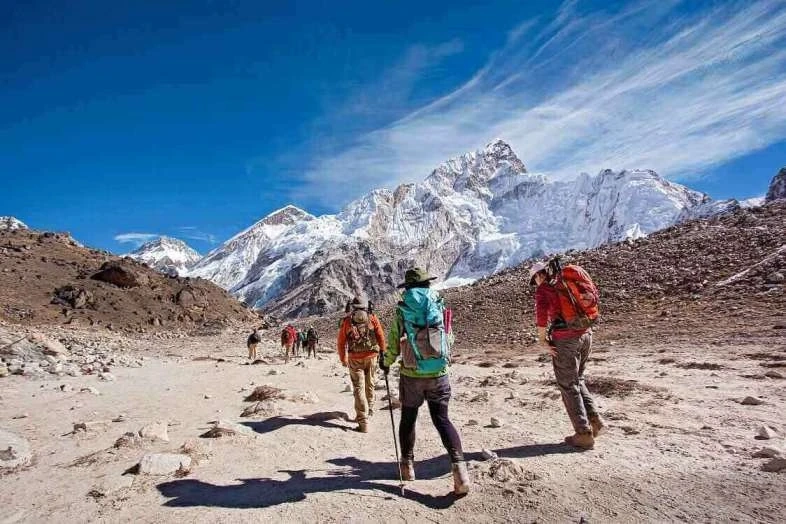Mount Everest has two Base Camps, the South Base Camp and the North Base Camp. The South Base Camp is located in Nepal at an altitude of 5,364 metres while the North Base Camp is located at an altitude of 5,150 metres. There are many things to consider when deciding which base camp to trek to.
Trekking to Everest Base Camp
If you are thinking about trekking to Everest Base Camp, there are many factors to consider. First of all, you\'ll want to pick a season. While trekking to Everest Base Camp is possible year-round, spring and autumn are the best times to go. The temperature in these months is mild, and there\'s a good chance of no rain or haze.
Typically, you\'ll eat three times a day and drink plenty of water. Food at the base camp is typically Nepali, Indian, and Western. Some of it is not the healthiest, and you may have trouble digesting it. Meat, for instance, may not be fresh at the higher altitudes. Since porters do not refrigerate meat, it\'s a good idea to stay away from it unless you\'re planning to make it yourself.
Route options
When considering route options to Everest Base Camp, it is important to understand the elevation gain and the time required. The most popular routes are those that begin in Lukla, Nepal. These treks can take twelve to fourteen days to complete. From Lukla, the trek is 80 miles round-trip, and the elevation gain is approximately 8,000 feet. Multiple rest days are required to acclimate to the altitude.
There are three main route options to Everest Base Camp. The first is the Everest Base Camp Trek, which is the most popular route. The other is the Three Passes Trek, which takes a circular route to EBC. It involves crossing Cho La and Kongma La (18,175 feet) as well as Renjo La (17,585 feet).
Overcrowding
In recent years, there has been an increase in the number of people in overcrowded areas on the Everest Base Camp. This is a concern for the environment and climbers. The amount of garbage generated by these climbers is huge, amounting to around 5,500 kg per year. The waste is discarded in drums that are carried to the lower area and emptied when full. Unfortunately, some of this waste ends up in nearby streams, contaminating them and causing disease among locals. The government of Nepal has not yet come up with a solution for this problem.
The increase in footfall has led to a shortage of accommodation in the area. While Nepal is one of the poorest countries in the world, it has an abundance of tourists, making it a popular destination for adventure-seekers. However, the country\'s history is marked by corruption, shoddy regulations, and a lack of proper preparation for mountaineering. The resulting crowdedness has posed a threat to the mountain\'s pristine beauty and remoteness.
Porters
Whether you\'re planning a day-trip to Everest Base Camp or a multi-day trek, porters play an integral role in the trek. You\'ll be able to use their equipment and know that you\'re in good hands, but remember to be respectful of their service. In addition, tips for porters vary based on region.
A porter is a local person who lives in the local area and who is accustomed to the altitude and climate. They are able to carry heavy loads and have spent their whole life working in mountainous areas. They\'ll help reduce your load so you won\'t have to carry as much as you would if you\'re doing it yourself. They can also help you avoid mountain sickness.
Kala Patthar viewpoint
The Kala Patthar viewpoint at Everest base camp offers an enviable vista of Mount Everest, the highest peak in the world. It is a short, easy hike that acclimates you to high altitude and provides panoramic views. It does not require any special training or climbing equipment. The only prerequisites are a positive attitude, physical fitness, and trekking poles.
The Kala Patthar viewpoint is 5,643 meters above sea level, and it offers a panoramic view of the Himalayan Range. You can even see Nuptse and Changtse. Though you won\'t see Everest, you will get a good glimpse of the surrounding landscape.
Sherpa guides\' opinions on shifting base camp
The Sherpa people of Nepal have been famed for their skill as mountain climbers\' guides. They earn well, but they also risk their lives every day. In fact, Sherpa guides are 10 times more likely to die on Everest than commercial fisherman. That makes them one of the most dangerous nonmilitary occupations on earth.
The mountaineering community is beginning to notice changes on the mountains. Every two years, Sherpa climbers go to Everest and make multiple trips up and down the mountain. As a result, the hard snow that they\'ve been used to has begun to deteriorate, leaving the route more dangerous. As a result, the number of people trying to climb Everest has increased, but hasn\'t decreased.
0
0
0



